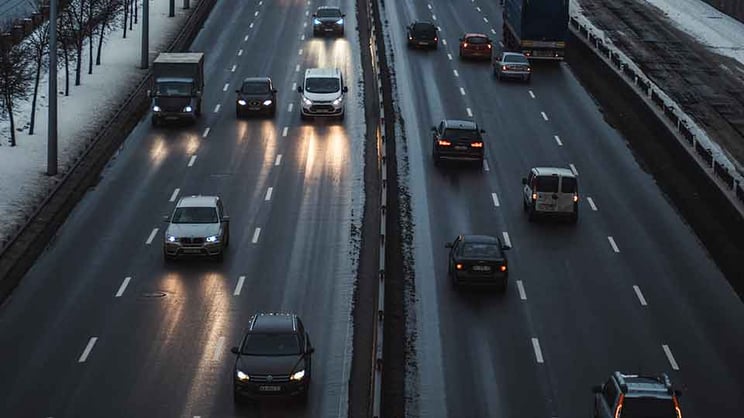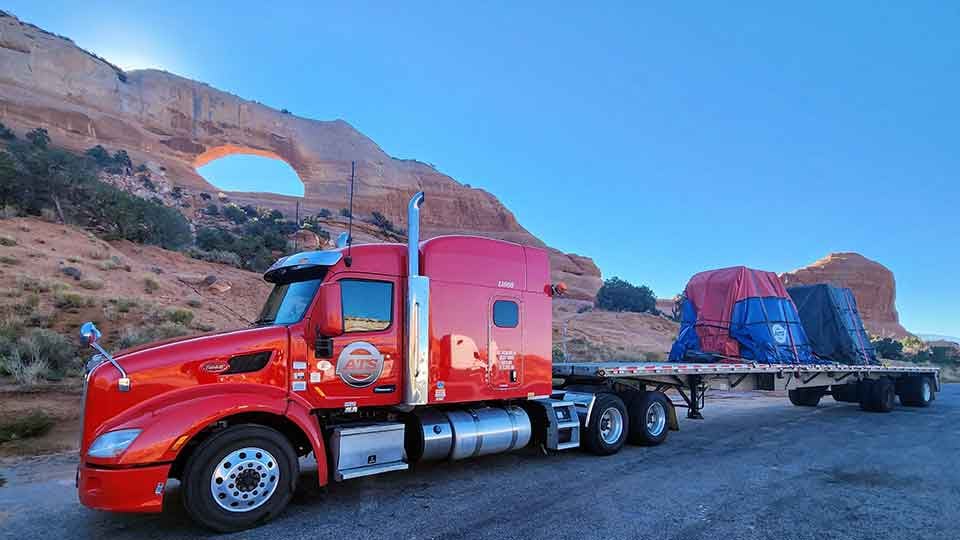Truck drivers are tasked with getting your freight safely from its point of origin to its final destination. Protecting your cargo also keeps the driver, the vehicle and others on the road safe. It’s the driver’s primary role, and they take it seriously.
When you are shipping cargo, rest assured that your driver and their carrier want it to arrive safely as much as you do. Here at Anderson Trucking Service (ATS), we’ve been moving cargo for over 65 years and we know that keeping it safe means keeping you happy, keeping our trucks on the road and keeping everyone safe.
Understanding securement, the laws that regulate securement and what types are available can take the mystery out of how your cargo will be protected as it is transported. This article will give you peace of mind as you begin to understand how a driver secures your cargo for its journey.

What Is Cargo Securement?
As you may have guessed from the root word, in the trucking industry “securement” is the process of keeping freight secure for the trip. Because no trip is completely predictable (drivers may have to brake quickly, take a sharp turn or make an unscheduled stop), securement keeps freight from sliding, falling or rolling — no matter what downward or sideways forces are placed on it.
No matter the type of trailer, securement usually starts with attaching the freight to it This keeps the freight in place and prevents most movement during the drive. Depending on the type, size and weight of the freight, this may be enough. Some combinations of trailer and cargo will need additional securements.
Legal Requirements for Load Securement
If securement fails, it can quickly become a public safety issue (loose cargo can cause accidents, property damage, injury to the driver or others on the road and even death). This means there are regulations that govern minimum requirements.
Securements are regulated by the Federal Motor Security Carrier Administration (FMSCA) through the North American Cargo Securement Standard. This standard regulates, among other things:
- At least one tie-down for every 10 feet of freight length
- Four additional tie-downs for every 10,000 lbs of freight weight
- All tie-down straps must be rated for at least half the total freight weight
- Carriers must follow the greater of all requirements
This is just the most basic overview of the FMSCA’s regulations. Before sending your freight off, be sure the driver understands the full set of regulations and is prepared to follow them.
If your driver and carrier fail to obey these laws, the consequences will be on them. No matter who you have chosen as your carrier, be sure they are trustworthy and follow every required guideline.
Cargo Securement in Dry Van and Flatbed Trailers
Dry vans are an enclosed shipping option. While some securement comes from the walls of the truck (be sure your driver knows if the walls will flex before depending on them to keep freight in place), this is not enough to prevent your freight from shifting and moving during transit.
The inside of a dry van protects from the elements, bugs and debris that may be present with other types of vehicles. Adding securements means your freight is also protected from damage caused by movement or impact.
Flatbed trailers of all sizes and heights are open to the elements. These unenclosed vehicles are visible to the public and undergo more scrutiny than dry vans. Securements on flatbeds have the added feature of helping the public “feel” safe by showing them your freight is properly loaded and secured.

Common Cargo Securement Techniques
The responsibility for securing the load falls on the driver. They will use one or more types of securement depending on the vehicle and freight and will have everything fully secure before leaving your site. Here are the most common items used to secure and protect freight during transport:
- Cargo bars: Also known as load bars or jack bars, cargo bars are placed at regular intervals in the interior of a dry van. These bars restrain the freight and provide an attachment point for straps, cords, chains or netting.
- Friction mats: Non-slip flooring that is combined with other securements to help keep freight from rolling or sliding around.
- Dunnage bags: Sturdy air-filled sacks that are inflated to occupy empty space in a dry van trailer and prevent load shift.
- E-tracks: Bars mounted to the wall of a dry van truck to hook ratchets, netting, straps and/or chains to.
- Blocks and chocks: Short restraints on the trailer’s floor that prevent wheels and round objects from rolling or skidding past a certain point.
- Nets: Attached to etracks or cargo bars, nets are contain freight within a certain area of the vehicle.
- Corner protectors: Placed on the corners of palletized freight, corner protectors keep the edges of the cargo from rubbing against the sides of the truck or other freight.
- Tie downs: Including chains, ratchet straps and bungee cords, various tie downs are used to attach cargo to a trailer. There are two types of tie-down attachments:
- Direct tie downs are attached to one side of the trailer. For example, a chain will be attached to the right side of the trailer, looped around the axle of a vehicle to be moved and then re-attached to the right side of the trailer. Regulations require direct tie downs for some types of vehicles during shipping.
- Indirect tie downs go from one side of the trailer to the other. For example, a chain will be attached to the right side of the trailer, fed through the eye of a coil, and then reattached to the left side of the trailer.
- Dunnage: Scrap material (often wood) used to keep the freight level and to prevent materials from rubbing against each other during the drive. Dunnage can also be used in place of chocks to prevent rolling or sliding.
- Racks: Shelving units securely attached to the trailer to stack smaller individual objects like pipe or lumber. Freight carried on racks may be attached to the rack and/or to the trailer itself.
- Stakes: Vertical bars placed along the sides of the trailer to confine the cargo to the trailer. These reinforce other securement options by keeping the freight contained in a specific area.
- Tarps: Plastic covers wrapped around the freight to protect it from the elements. While not a traditional securement, tarps protect your cargo from damage.
- Over-dimensional load markers: Placed on all four sides of a truck carrying loads that are permitted to exceed legal limits in one or more ways. These markers inform other motorists and give them extra caution along the road.
Your carrier should provide all needed securements. If you have questions about what will be used or wish to inspect the load once it is secured, ask your driver.
Download the Freight Carrier Vetting Guide.
The Customer’s Responsibility in Freight Securement
As noted earlier, it is ultimately the carrier’s responsibility to deliver your freight safely and on time. But by taking a few simple steps, you will be helping protect your valuable assets during transit. Here’s what you can do:
Specify Your Details
As soon as possible, let the carrier know the type of cargo you will be shipping, as well as the length, width, height and weight. This helps the carrier prepare with the right vehicle and the right type and number of securements.
If your needs change, convey that information as soon as possible. In trucking, providing clear and thorough information to your provider is one of the best ways to keep your shipment moving securely and on time.
Share Your Experience
You are the expert in your specific commodity. If you have experience with different carriers and different types of securement they have used, share it with the customer service representative and driver. They may use that information along with FMSCA regulations and their own experience to fully secure your load.
Prepare for Unloading
If your freight will be unloaded with a crane or forklift, be sure the freight is loaded in a way that you can access it, such as on pallets.
Securing Your Freight During Shipping
The most important thing to remember when shipping freight is that, while it is the carrier’s responsibility, you can help the process by communicating clearly and often. When you choose a transportation provider, be prepared to answer questions about what you will be shipping, including specifications for every leg of the trip.
No matter the distance or freight you will be moving, securements are vital in making sure it arrives unharmed. By understanding the types of securements and specifying your needs to the carrier, you can help protect your valuable cargo.
Once you know what you will be shipping, contact the ATS team. Our experienced representatives will provide an estimate, including needed equipment and securements for the drive.




